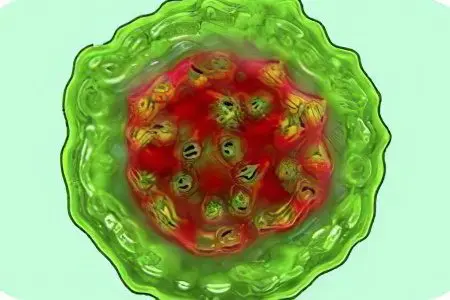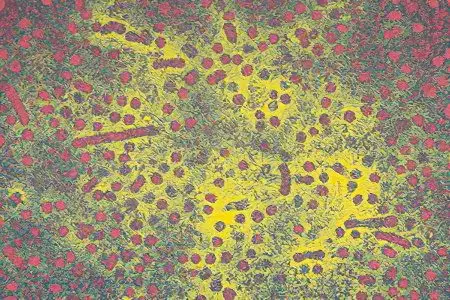Contents
What is hepatitis D?
Hepatitis D is a viral anthroponotic infection that causes damage to the liver. A prerequisite for the development of the disease is the presence of a concomitant virus – hepatitis B. Due to this factor, the process of replication of the delta infection occurs. The hepatitis D virus does not have its own membrane, so it needs a cell coating of the B virus. This coinfection causes serious problems with the liver.
Causes of hepatitis D

The cause of hepatitis D is the causative agent of infection – RNA containing a viral particle. The RNA molecule carries the genetic information of the virus, protected by a protein coat. It contains an antigen that was also found in the hepatitis B virus. This fact allowed specialists to find out that the reproduction of hepatitis D viral particles is impossible without hepatitis B pathogens.
Infection can occur in the following ways:
through blood transfusion. According to statistics, 2% of all donors are carriers of viral hepatitis. In this regard, a thorough blood test is carried out, but this does not exclude the possibility of infection. The risk of transfusion of blood containing the hepatitis D virus is especially high for patients with multiple repetitions of the procedure.
sexually. Thus, the hepatitis B virus most often enters the human body. If there is already a hepatitis D virus in the blood, this will cause it to multiply and develop the disease.
repeated use of the same needle in non-sterile conditions. It is no coincidence that the percentage of patients with hepatitis D among drug addicts is so high. In most cases, the cause of the disease is the use of the same needle by different people. Infection is possible during procedures such as acupuncture, piercing, tattoos. Due to the ingress of the hepatitis D virus into the body while non-compliance with sterile conditions.
infection of children in the womb. This way of appearance of hepatitis D virus in the body is known as vertical. The greatest probability of infection in women suffering from acute hepatitis in the later stages. The risk of the disease increases many times if she also has HIV infection. Hepatitis D is transmitted from mother to child only in some cases. For example, the possibility of infection with milk is excluded.
These are the main ways the infection spreads. In many cases, the cause of infection and how the hepatitis D virus enters the human body remains unknown.
Symptoms of hepatitis D
Symptoms of hepatitis D are similar to other types of this disease. Usually, this virus causes a complication in the presence of hepatitis B. The development of coinfection in this case takes from 3 to 5 days, and superinfection – from several weeks to 2 months. The preicteric period is characterized by weakness in patients, lack of appetite, nausea, turning into vomiting. There may be pain in the knee joints and liver, fever.
In the icteric period, actively progressive and severe intoxication is observed. With superinfection, edematous-ascitic syndrome appears early. It is very difficult to distinguish it from hepatitis B due to similar symptoms. Superinfection is difficult. Recovery takes much longer than with hepatitis B. In addition, hepatitis D causes complications that negatively affect liver cells. It, like the spleen, increases in size. On the skin, these complications appear in the form of spider veins. Hepatic edema and ascites are also common in hepatitis D.
Types of hepatitis D

Based on the fact that the hepatitis D virus is closely related to the causative agent of hepatitis B, the following types of infection are distinguished:
Coinfection. It involves the simultaneous entry of hepatitis D and B viruses into the body. Most often in this case, the infection proceeds passively, and the outcome is favorable. Hepatitis does not require treatment and goes away after a while without medical attention. However, sometimes viruses cause an acute form of the disease, which leads to serious consequences. The liver suffers the most.
Superinfection. The hepatitis D virus appears after the B virus enters the body. This form is more severe than co-infection, so in most cases patients need qualified medical care. The percentage of spontaneous elimination of the virus is very low.
Diagnosis and treatment of hepatitis D
Diagnostics hepatitis D involves a biochemical blood test, as a result of which specific antibodies are usually found in the blood. Since this virus affects the liver cells, an ultrasound scan of this organ, rheohepatography is performed. In some cases, they resort to the help of a puncture biopsy. At the diagnostic stage, it is important to confirm the presence of the hepatitis D virus and to distinguish it from other types.
The main method of treatment of this disease – interferon therapy. This drug is considered the most effective in hepatitis. Depending on the type of disease, the dosage and frequency of taking interferon are individually prescribed. In hepatitis D, treatment with this drug continues until a normal level of serum transaminases in the blood is reached. interferon is taken either daily or several times a week. Depending on this, the dose is determined.
Medication allows you to prevent the development of cirrhosis of the liver, stop the reproduction of the hepatitis D virus. In most patients, during the first few months of taking interferon, the clinical symptoms of the disease disappear, inflammation decreases. After hepatitis D, it takes a long period of time to restore the normal functioning of the liver. To avoid the development of the disease and the complications it causes, such as cirrhosis or hepatic coma, regular vaccination is necessary.









